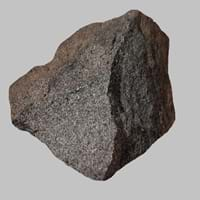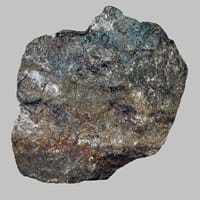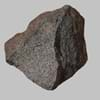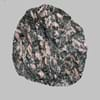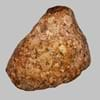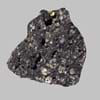Definition
Appinite is an igneous rock in which the crystals are so fine grained that individual minerals cannot be easily distinguished
Monzonite is a granular igneous rock with composition between syenite and diorite and containing approximately equal amounts of orthoclase and plagioclase
Origin
Unknown
Trento Province, Italy
Discoverer
Unknown
Unknown
Etymology
From the variety of Lamprophyre Greek lampros bright and shining + porphureos purple
From Mount Monzoni in the Tyrol, Italy, + -ite1
Class
Igneous Rocks
Igneous Rocks
Sub-Class
Durable Rock, Medium Hardness Rock
Durable Rock, Hard Rock
Other Categories
Coarse Grained Rock, Fine Grained Rock, Opaque Rock
Coarse Grained Rock, Fine Grained Rock, Medium Grained Rock, Opaque Rock
Texture
Porphyritic
Phaneritic
Color
Black, Bluish - Grey, Brown, Dark Greenish - Grey, Green, Grey
Black, Brown, Light to Dark Grey, White
Durability
Durable
Durable
Scratch Resistant
Yes
Yes
Appearance
Dull, Banded and Foilated
Shiny
Interior Uses
Decorative Aggregates, Homes, Interior Decoration
Decorative Aggregates, Flooring, Interior Decoration
Exterior Uses
Paving Stone, Garden Decoration, Office Buildings
As Building Stone, As Facing Stone, Office Buildings, Paving Stone
Other Architectural Uses
Whetstones
Curbing
Construction Industry
As Dimension Stone, Cement Manufacture, for Road Aggregate, Making natural cement, Manufacture of Magnesium and Dolomite Refractories
As Dimension Stone, Cement Manufacture, Construction Aggregate, for Road Aggregate
Medical Industry
Taken as a Supplement for Calcium or Magnesium
Not Yet Used
Antiquity Uses
Artifacts, Monuments, Sculpture, Small Figurines
Artifacts, Monuments, Sculpture
Commercial Uses
An Oil and Gas Reservoir, As a Feed Additive for Livestock, Gemstone, Metallurgical Flux, Production of Lime, Soil Conditioner
Creating Artwork
Types
Not Available
Quartz Monzonite, Mangerite, Syenite and Diorite
Features
Always found as volcanic pipes over deep continental crust, Host rock for Diamond, Is one of the oldest rock, Surfaces are often shiny
Available in lots of colors, Is one of the oldest rock
Archaeological Significance
Famous Monuments
Data Not Available
Data Not Available
Famous Sculptures
Data Not Available
Data Not Available
Pictographs
Used
Not Used
Petroglyphs
Used
Not Used
Formation
The formation of Appinite takes place deep beneath the Earth’s surface at around 150 to 450 kms, and are erupted rapidly and violently.
Monzonite is a fine-grained, hard rock which is a type of metasomatite, essentially altered basalt. It forms with or without crystallization, either below the surface as intrusive rocks or on the surface as extrusive rocks.
Mineral Content
Amphibole, Carbonate, Garnet, Micas, Olivine, Phlogopite, Pyroxene
Albite, Amphibole, Apatite, Biotite, Feldspar, Hornblade, Ilmenite, Magnetite, Muscovite or Illite, Olivine, Plagioclase, Pyroxene, Quartz, Sulfides, Titanite, Zircon
Compound Content
Aluminium Oxide, NaCl, CaO, Iron(III) Oxide, FeO, Potassium Oxide, MgO, MnO, Sodium Oxide, Silicon Dioxide, Titanium Dioxide
Aluminium Oxide, CaO, Iron(III) Oxide, FeO, Potassium Oxide, MgO, MnO, Sodium Oxide, Phosphorus Pentoxide, Silicon Dioxide, Titanium Dioxide
Types of Metamorphism
Burial Metamorphism, Cataclastic Metamorphism, Contact Metamorphism, Hydrothermal Metamorphism, Regional Metamorphism
Burial Metamorphism, Cataclastic Metamorphism, Impact Metamorphism
Types of Weathering
Chemical Weathering, Mechanical Weathering
Biological Weathering
Types of Erosion
Chemical Erosion, Water Erosion, Wind Erosion
Chemical Erosion, Coastal Erosion, Glacier Erosion, Water Erosion
Grain Size
Fine to Coarse Grained
Medium to Fine Coarse Grained
Fracture
Conchoidal
Not Available
Porosity
Very Less Porous
Less Porous
Luster
Subvitreous to Dull
Subvitreous to Dull
Compressive Strength
Not Available
Cleavage
Conchoidal
Not Available
Toughness
Not Available
Not Available
Specific Gravity
2.86-2.87
2.8-3
Transparency
Translucent to Opaque
Opaque
Density
2.95-2.96 g/cm3
2.9-2.91 g/cm3
Specific Heat Capacity
Not Available
Resistance
Heat Resistant, Impact Resistant
Heat Resistant, Impact Resistant, Pressure Resistant
Deposits in Eastern Continents
Asia
Russia
China, India, Iran, Saudi Arabia, Sri Lanka, Taiwan, Thailand, Turkey, Vietnam
Africa
Angola, Botswana, Cameroon, Ethiopia, South Africa
Angola, Egypt, Ethiopia, Madagascar, Namibia, Nigeria, South Africa
Europe
England, Hungary, Iceland, United Kingdom
Bulgaria, England, Germany, Norway, Romania, Switzerland
Others
Antarctica, Greenland
Not Yet Found
Deposits in Western Continents
North America
Canada, Mexico, USA
USA
South America
Argentina, Colombia, Ecuador
Argentina, Bolivia, Brazil, Chile, Colombia, Ecuador, Peru
Deposits in Oceania Continent
Australia
New South Wales, New Zealand, Queensland, South Australia, Western Australia
New South Wales, New Zealand, Queensland, South Australia, Western Australia
Appinite vs Monzonite Characteristics
Though some rocks look identical, they have certain characteristics which distinguish them from others. Characteristics of rocks include texture, appearance, color, fracture, streak, hardness etc. Appinite vs Monzonite characteristics assist us to distinguish and recognize rocks. Also you can check about Properties of Appinite and Properties of Monzonite. Learn more about Appinite vs Monzonite in the next section. The interior uses of Appinite include Decorative aggregates, Homes and Interior decoration whereas the interior uses of Monzonite include Decorative aggregates, Flooring and Interior decoration. Due to some exceptional properties of Appinite and Monzonite, they have various applications in construction industry. The uses of Appinite in construction industry include As dimension stone, Cement manufacture, For road aggregate, Making natural cement, Manufacture of magnesium and dolomite refractories and that of Monzonite include As dimension stone, Cement manufacture, Construction aggregate, For road aggregate.
More about Appinite and Monzonite
Here you can know more about Appinite and Monzonite. The life cycle of a rock consists of formation of rock, composition of rock and transformation of rock. The composition of Appinite and Monzonite consists of mineral content and compound content. The mineral content of Appinite includes Amphibole, Carbonate, Garnet, Micas, Olivine, Phlogopite, Pyroxene and mineral content of Monzonite includes Albite, Amphibole, Apatite, Biotite, Feldspar, Hornblade, Ilmenite, Magnetite, Muscovite or Illite, Olivine, Plagioclase, Pyroxene, Quartz, Sulfides, Titanite, Zircon. You can also check out the list of all Igneous Rocks. When we have to compare Appinite vs Monzonite, the texture, color and appearance plays an important role in determining the type of rock. Appinite is available in black, bluish - grey, brown, dark greenish - grey, green, grey colors whereas, Monzonite is available in black, brown, light to dark grey, white colors. Appearance of Appinite is Dull, Banded and Foilated and that of Monzonite is Shiny. Properties of rock is another aspect for Appinite vs Monzonite. The hardness of Appinite is 5-6 and that of Monzonite is 6-7. The types of Appinite are Not Available whereas types of Monzonite are Quartz Monzonite, Mangerite, Syenite and Diorite. Streak of rock is the color of powder produced when it is dragged across an unweathered surface. The streak of Appinite and Monzonite is white. The specific heat capacity of Appinite is Not Available and that of Monzonite is 0.92 kJ/Kg K. Depending on the properties like hardness, toughness, specific heat capacity, porosity etc., rocks are resistant to heat, wear, impact, etc.Appinite is heat resistant, impact resistant whereas Monzonite is heat resistant, impact resistant, pressure resistant.
